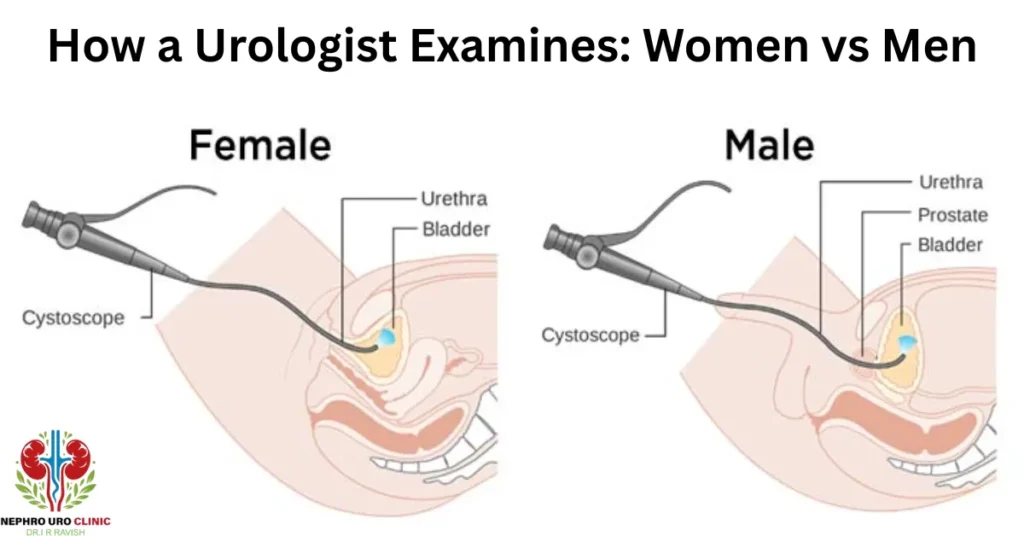A urologist is a medical doctor who specializes in diagnosing and treating conditions related to the urinary tract and male reproductive system. Whether you’re dealing with frequent urination, prostate concerns, or fertility issues, their role is essential to uncovering the root of discomfort. So, how does a urologist examine you? Let’s walk through the experience with clarity and confidence.
Who Should See a Urologist?
- Men over 50 with prostate concerns: Prostate health becomes a priority as men age. A urologist evaluates prostate size, checks for enlargement or cancer risks, and may recommend a digital rectal exam. Early detection through routine checks can significantly reduce complications later.
- Individuals with urinary symptoms: Symptoms like burning while urinating, urgency, blood in the urine, or nighttime urination are red flags. A urologist investigates these signs through physical exams, urine tests, and imaging to pinpoint conditions like infections, stones, or structural problems.
- Couples facing fertility challenges: When pregnancy doesn’t happen as expected, male factors might be involved. Urologists assess sperm count, testicular health, hormone levels, and potential blockages. Understanding how does a urologist examine you in this context can guide couples toward effective solutions.
What Should You Expect During Your First Urologist Visit?
- Thorough medical history review: Your urologist will begin by asking detailed questions about your symptoms, lifestyle habits, medical history, and any medications you’re currently taking. This context helps them understand what might be triggering your condition before determining how does a urologist examine you.
- Discussion of sensitive issues with care: Topics like sexual function, fertility, or urinary problems may be discussed. Whether you’re a man concerned about prostate health or a woman with bladder issues, understanding how does a urologist examine a woman or a man helps ease anxiety.
- Explanation of next steps: After the initial conversation, the doctor will outline what evaluations are necessary. This may include physical exams, lab tests, or imaging. Everything is explained clearly, and you’re encouraged to ask questions without hesitation.
What Does a Urologist Do on the First Visit?
- General and focused physical examination: The urologist may begin with a general physical check, then focus on the urinary or reproductive organs based on your symptoms. For men, this might include a testicular or prostate exam. For women, the focus could shift to bladder and pelvic assessments, highlighting how does a urologist examine a woman specifically.
- Urinalysis or blood tests: Depending on your symptoms, a urine sample may be collected to detect infections, blood, or other abnormalities. Blood tests might assess kidney function, PSA levels for prostate screening, or hormone levels related to fertility or sexual health.
- Discussion of potential diagnostic procedures: If further clarity is needed, your urologist may suggest imaging tests, cystoscopy, or urodynamic studies. These tests are explained step-by-step, ensuring you understand how does a urologist examine you using both physical and technological tools.
What Will Happen During the Exam?
- Focused abdominal and genital examination: The urologist begins by gently palpating your abdomen to assess the bladder and kidneys. For men, this may include examining the penis and testicles to check for abnormalities like lumps, swelling, or pain. These steps help determine how does a urologist examine you during an in-depth check.
- Digital rectal exam (DRE) for men: This involves inserting a gloved, lubricated finger into the rectum to feel the prostate. Though brief, this step is crucial in detecting enlargement or hard nodules that may suggest prostate issues. It’s a routine part of male urological assessments.
- Pelvic or bladder exam for women: To understand how does a urologist examine a woman, the doctor may conduct a pelvic exam, especially if urinary incontinence or pelvic pain is involved. They may also check for bladder prolapse or infections during this stage of the exam.

How Does a Urologist Perform a Physical Examination?
- Visual and manual inspection: The urologist starts by visually checking the genital area for any swelling, redness, or abnormal discharge. They may palpate the groin and lower abdomen to detect hernias or tenderness.
- Prostate and testicular exam for men: A digital rectal exam checks the prostate’s size and texture, while the testicles are examined for masses or pain. This step helps assess risks for cancer or infections.
- Pelvic exam for women: The doctor may examine the external genitalia and feel the pelvic area for signs of prolapse, masses, or tenderness. This helps understand how does a urologist examine you in relation to bladder or pelvic issues.
What Does a General Physical Exam Involve?
- Vital signs and general health check: The visit often begins with measuring blood pressure, temperature, heart rate, and weight. These indicators help the urologist evaluate your overall health and detect systemic concerns that may impact the urinary or reproductive system.
- Abdominal and flank examination: The doctor gently presses on your abdomen and sides to feel for any tenderness, swelling, or abnormal masses near the kidneys and bladder. It also helps in evaluating pain related to kidney stones or infections.
- Assessment related to sexual health: If erectile dysfunction is a concern, the urologist may check hormonal signs, penile structure, or vascular health. Knowing how does a urologist examine you for erectile dysfunction can reassure patients seeking sensitive yet essential care.
How Is a Pelvic Exam Conducted for Males and Females?
- Pelvic exam in males: The urologist examines the penis, testicles, and scrotum for swelling, pain, or abnormalities. They may also evaluate the prostate through a digital rectal exam if symptoms suggest prostate involvement, helping answer how does a urologist examine you for erectile dysfunction or urinary issues.
- Pelvic exam in females: The doctor assesses the external genital area and may perform an internal exam to check for bladder prolapse or pelvic organ positioning. If urinary incontinence is present, bladder control is also evaluated. This illustrates what does a urologist do on the first visit for women with pelvic symptoms.
What Is a Digital Rectal Exam and Why Is It Important?
- Purpose of the exam: A digital rectal exam (DRE) helps the urologist assess the prostate’s size, shape, and texture. It is a key screening tool for prostate enlargement, inflammation, or signs of prostate cancer, especially in men over 50.
- How it’s performed: The doctor inserts a gloved, lubricated finger into the rectum while the patient is in a relaxed position. Though slightly uncomfortable, the exam is quick and offers vital insights into prostate health. This step is essential when asking how does a urologist examine you during a prostate check.
Examination of Male Urologic Disease
- Initial examination: The doctor evaluates symptoms, examines the genital area, and performs a digital rectal exam if needed. They may also assess for testicular lumps, penile abnormalities, or hernias.
- Laboratory examination: Urine and blood tests are used to check kidney function, infections, hormone levels, or prostate-specific antigen (PSA). Semen analysis may be ordered for fertility concerns.
- Urodynamic testing: This test measures bladder pressure, urine flow, and sphincter control. It’s helpful in diagnosing incontinence, urinary retention, or bladder dysfunction.
- Endoscopic exam: Using a thin scope called a cystoscope, the doctor can visualize the urethra and bladder interior. This helps detect tumors, blockages, or structural abnormalities.
- Ultrasound diagnostics: Ultrasound is used to visualize the kidneys, bladder, prostate, or testicles. It’s non-invasive and helpful in identifying stones, swelling, or tumors.
- Radiation method of examination: CT scans or MRIs offer more detailed imaging when needed. These are used for evaluating complex kidney stones, tumors, or abnormal urinary tract anatomy.
Examination of Female Urologic Disease
- Physical test: The urologist inspects the pelvic and lower abdominal region. They may check for bladder prolapse, vaginal wall support, or tenderness in the pelvic floor muscles.
- Note down answers: Detailed notes are taken based on symptoms like urinary leakage, pain, or urgency. These notes guide further tests and ensure an accurate diagnosis tailored to female anatomy.
- Urine collection: A clean-catch urine sample is collected to check for infections, blood, or abnormal cells. This is a basic yet essential test when evaluating urinary symptoms in women.
- In-depth tests: Advanced tests like urodynamic studies or cystoscopy may follow. These help assess bladder function and internal urinary tract structures, clarifying what does a urologist do on the first visit and how does a urologist examine you for erectile dysfunction in related female cases.
What Urine Tests Does a Urologist Typically Order?
- Urinalysis: This is a standard test used to detect infections, blood, protein, or sugar in the urine. It helps identify issues like UTIs, kidney problems, or diabetes-related complications, forming a basic but crucial part of how does a urologist examine you.
- Urine culture: If infection is suspected, a culture identifies the specific bacteria causing the problem. It ensures that the prescribed antibiotics target the right strain, especially in recurrent or resistant cases.
- 24-hour urine test: This test measures kidney function, minerals, and waste products over a full day. It is particularly useful for patients with kidney stones or unexplained urinary abnormalities.
- Urine cytology: This involves examining urine under a microscope to detect abnormal or cancerous cells. It’s often ordered when blood is present in urine without infection.
What Imaging Tests Does a Urologist Use for Diagnosis?
- Ultrasound: Ultrasound is often the first imaging test used to view the kidneys, bladder, testicles, or prostate. It’s non-invasive and helps detect stones, tumors, cysts, or blockages—offering a clear look into how does a urologist examine you without radiation exposure.
- CT scan (Computed Tomography): CT scans provide detailed cross-sectional images, particularly useful for diagnosing complex kidney stones, tumors, or structural abnormalities. It gives a more precise view than ultrasound when deeper evaluation is needed.
- MRI (Magnetic Resonance Imaging): MRI is typically used for soft tissue assessment, such as the prostate or pelvic floor. It’s effective in evaluating prostate cancer and congenital abnormalities of the urinary system.
- X-rays and KUB (Kidney-Ureter-Bladder): These are used to locate visible kidney stones or blockages. While limited in detail compared to CT, X-rays offer quick insights, especially in emergency evaluations.
Conclusion
Understanding how does a urologist examine you helps replace anxiety with clarity. Whether it’s a simple urine test or a more involved pelvic or prostate exam, each step is designed with your health and comfort in mind. Don’t delay care—timely evaluation can make all the difference in your outcome. Prioritize your well-being and take the first step confidently.




